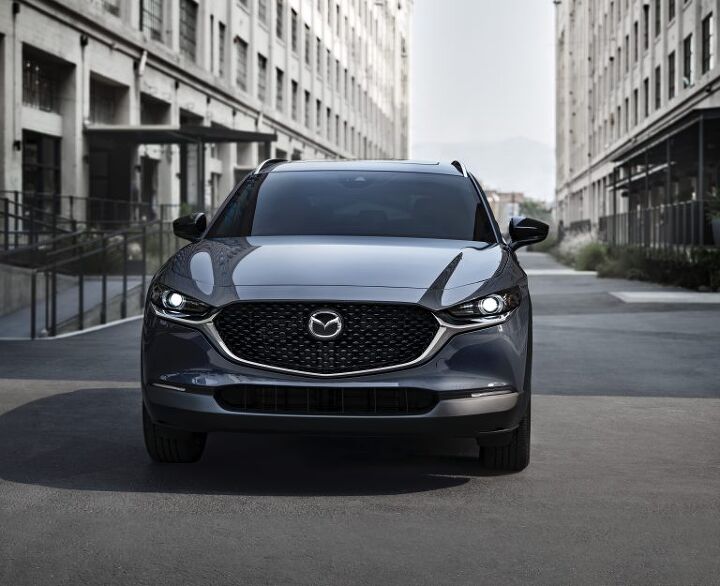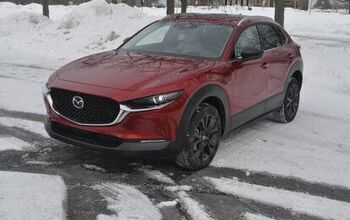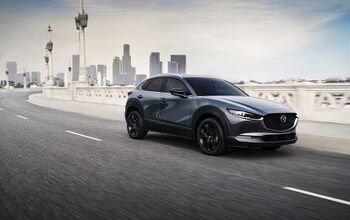It's Turbo Time: Mazda Boosts the CX-30

If you ever thought, “Gee, I like this Mazda CX-30, but it could stand to offer a skoosh more power”, well, Mazda has news for you.
Yes, that’s right – “dude, you’re getting a turbo!”
The now available 2.5-liter four-cylinder turbo will make 250 horsepower and 320 lb-ft of torque when running premium (93 octane) fuel. If you’re running 87 octane, you cheapskate, you’ll drop to 227 ponies and 310 lb-ft.
Those numbers represent a big jump over the 186/186 presented by the 2.5-liter naturally-aspirated engine.
All-wheel drive is standard. Mazda didn’t mention a transmission, but it is likely to be the six-speed from the non-turbo CX-30.
Some new safety features will be available, too. Rear-cross traffic braking, traffic-jam assist, and a 360-degree camera among them.
The subcompact crossover’s exterior has specific changes for Turbo models. They will have 18-inch black aluminum-alloy wheels, larger tailpipes, gloss black door mirrors, and “Turbo” badging on the liftgate.
The 2021 Mazda CX-30 Turbo should be available by the end of 2020 (just like a coronavirus vaccine, hopefully). Pricing and details about specific trim/packaging options will be announced later.
Presumably, so will fuel economy numbers. Nothing is listed on the Environmental Protection Agency’s fuel-economy research site, as of yet.
A turbo CX-30 could end up being a fun little runabout, though the last one I tested ran through fuel fast. Not because of poor mpg, but because of a small fuel tank. A drive from Chicago to Detroit, around Detroit/Windsor, and back, required more refills than it should. A turbo will likely suck fuel even faster, but then again, the extra power will almost certainly be appreciated.
[Images: Mazda]

Tim Healey grew up around the auto-parts business and has always had a love for cars — his parents joke his first word was “‘Vette”. Despite this, he wanted to pursue a career in sports writing but he ended up falling semi-accidentally into the automotive-journalism industry, first at Consumer Guide Automotive and later at Web2Carz.com. He also worked as an industry analyst at Mintel Group and freelanced for About.com, CarFax, Vehix.com, High Gear Media, Torque News, FutureCar.com, Cars.com, among others, and of course Vertical Scope sites such as AutoGuide.com, Off-Road.com, and HybridCars.com. He’s an urbanite and as such, doesn’t need a daily driver, but if he had one, it would be compact, sporty, and have a manual transmission.
More by Tim Healey
Latest Car Reviews
Read moreLatest Product Reviews
Read moreRecent Comments
- Plaincraig 1975 Mercury Cougar with the 460 four barrel. My dad bought it new and removed all the pollution control stuff and did a lot of upgrades to the engine (450hp). I got to use it from 1986 to 1991 when I got my Eclipse GSX. The payments and insurance for a 3000GT were going to be too much. No tickets no accidents so far in my many years and miles.My sister learned on a 76 LTD with the 350 two barrel then a Ford Escort but she has tickets (speeding but she has contacts so they get dismissed or fine and no points) and accidents (none her fault)
- Namesakeone If I were the parent of a teenage daughter, I would want her in an H1 Hummer. It would be big enough to protect her in a crash, too big for her to afford the fuel (and thus keep her home), big enough to intimidate her in a parallel-parking situation (and thus keep her home), and the transmission tunnel would prevent backseat sex.If I were the parent of a teenage son, I would want him to have, for his first wheeled transportation...a ride-on lawnmower. For obvious reasons.
- ToolGuy If I were a teen under the tutelage of one of the B&B, I think it would make perfect sense to jump straight into one of those "forever cars"... see then I could drive it forever and not have to worry about ever replacing it. This plan seems flawless, doesn't it?
- Rover Sig A short cab pickup truck, F150 or C/K-1500 or Ram, preferably a 6 cyl. These have no room for more than one or two passengers (USAA stats show biggest factor in teenage accidents is a vehicle full of kids) and no back seat (common sense tells you what back seats are used for). In a full-size pickup truck, the inevitable teenage accident is more survivable. Second choice would be an old full-size car, but these have all but disappeared from the used car lots. The "cute small car" is a death trap.
- W Conrad Sure every technology has some environmental impact, but those stuck in fossil fuel land are just not seeing the future of EV's makes sense. Rather than making EV's even better, these automakers are sticking with what they know. It will mean their end.






































Comments
Join the conversation
Yummy. I like it.
I'm utterly ambivalent about fuel tank size as long as the fuel economy rating is high enough. I recall my 1995 Accord with its 17 gallon tank, one of the larger fuel tanks in a car I've owned. Given my habit of filling from half tank, something I picked up from my dad, I used to go in every 5 or 6 days. With my current car, what has a 12.7 gallon tank, I'm in every 4 or 5 days. It doesn't bother me much considering I like to buy a bottle of pop often enough and stopping for the extra 5 minutes isn't too much of a hassle to me. What I've noticed is that in adverts there will be a more prominently quoted range for a given vehicle, with no real reference to tank size. "Our vehicle, X, has a 350 range while its competitor, vehicle Y, only has a 300 range." This often hides that vehicle X gets 20 mpg out of 17.5 gallons, while vehicle Y gets 30 mpg out of 10 gallons***. All things equal I'd take vehicle Y with the shorter range, but better mileage. ***Numbers being pulled directly from the fundament for illustrative purposes only.